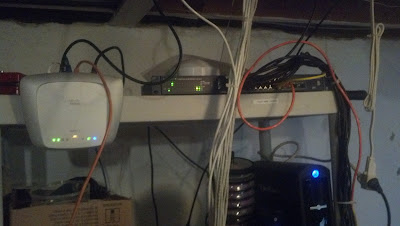So it's been a solid 3 years (already?! Yikes!) and I've done a lot of work revolving around my home network infrastructure. An insane amount of changes have occurred around my server/network setup and I love how things are going in that regard. Let's review some of the largest/most important changes I've made:
- General upgrades. I've finally obtained an ACTUAL network rack! It's a Tripp Lite 42- or 45U rack (can't remember which--will add at some point later on). This big boy cost me about $150 wih free shipping if I remember correctly--gotta love NewEgg!
- Wireless upgrades. I've made a load of changes in this area: I've gone from Cisco APs to a Linksys router, back to Aruba APs, only to switch to Cisco again and back to Aruba finally. I think I've finally settled on a solid setup. After trying Ubiquiti's UAP-AC-LITE access points and not liking them as well as I'd hoped I would, I'm currently enjoying 802.11ac TP-Link access points. They operate at both the 2.4GHz and 5GHz bands, boast 1.2Gbps max throughput and 802.3af Power-over-Ethernet technology, and look really great mounted on my ceiling (basement AP) and sitting in a corner (back room AP).
- The most important aspects that I needed to have in a WLAN infrastructure were 802.3af PoE and a centralized management interface. Both points are met with the TP-Link EAP225 access points.
- Server upgrades. I went from a single, 4-bay Dell server with 32GB RAM and about 2-point-something TB of redundant storage space to a single, 2-bay Dell server with 32 GB RAM and just under 1TB of storage space for a few reasons. The primary reason was power consumption; I originally had both servers running 24/7/365 which was costing an arm and a leg, so I had to cut that down. I'm now running a single Dell PowerEdge 1950 which is absolutely perfect for the needs-versus-cost argument. Also, I pay about $20 per month for 2TB of Google Drive storage space (nice, huh?) for backups and media storage.
- Switching/network core upgrades. I am now operating two 48-port network switches (1 for PoE devices and 1 for non-PoE devices). I have a Nortel 4548GT-PWR Gigabit PoE switch for my WLAN power and a Nortel 5510-48T for wired devicess connections around the house. A few more upgrades are supposed to be arriving over the next three days: I have purchased a Nortel 5530 24-port switch, which has 12 GbE ports, 12 Gigabirt copper/SFP combo ports and 2 10GbE XFP ports. The 5530 will be an MDF of sorts; I plan on using its fiber-based ports to create a fiber network core in my home. I'll then use 4 of the copper-only ports to create a 4Gb backhaul to my router (also brand new! It's a MikroTik Routerboard and I freakin' love it!); I'll then use the SFP ports to connect my 4548GT-PWR to the MDF with a 4Gb backhaul as well. Finally, I plan to create a 2Gb copper connection between the MDF and my PowerEdge 1950 by bonding two copper ports on the MDF.
- Router upgrades. Back in January, I purchased a MikroTik RB2011UiAS-RM from Amazon for about $129.99 (possibly less). Since then, I've been constantly tinkering with it and have the following network setup (so far!):
- Untagged VLAN 1 is for the primary core of the network (wired and secure wireless connections). This WLAN has a MAC accress filter applied in whitelist form to allow only certain devices on it.
- Tagged VLAN 172 is for guest wireless connections (unencrypted, isolated network for whoever wants/needs to use it).
- Tagged VLAN 192 is for non-family, secure connections (trusted friends who just need secure Internet access)
If you'd like to see a PDF version of the upcoming network re-vamp, please click this link to view it in Google Drive.
That's all for tonight--me need sleep now.








